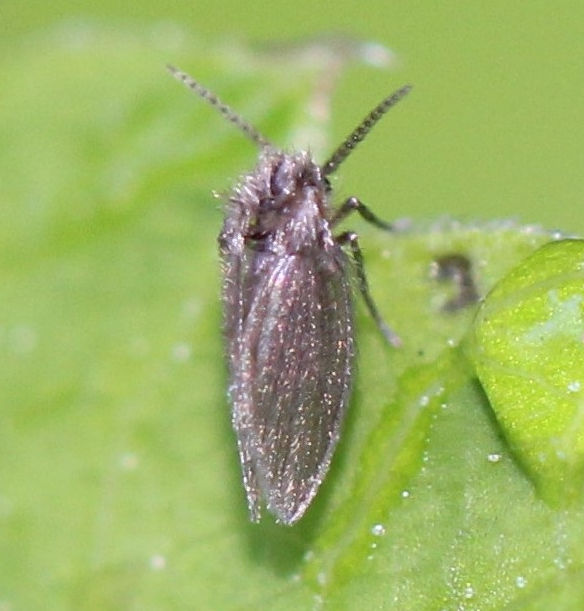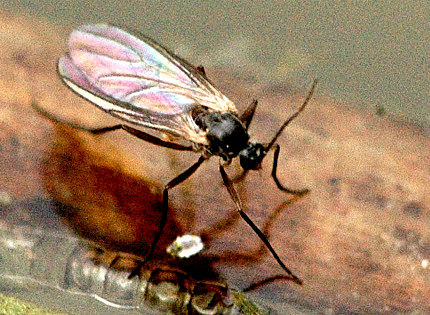- Home
- Garden Wildlife
- Insects
- True flies
- Compost flies
Compost flies
Many flies (and other insects) are associated with decaying plant material, which a compost heap or bin provides in abundance. Rotting plant material produces lots of soupy liquid which is ideal for flies. These insects often go unnoticed in open compost heaps but are more readily seen in compost bins and wormeries that are covered with a lid. When the lid is removed to add more material, light enters the dark interior of the bin, encouraging the disturbed flies to take flight.
Many fly families have species that develop as larvae in rotting plant material. Those flies that are most likely to be seen in compost bins are in the Psychodidae or moth flies, the Sciaridae or dark-winged fungus gnats, and the Drosophilidae or fruit flies.
Species in Britain and Ireland
In Britain and Ireland there approximately 400 species of flies in these three groups, but not all are rotting plant material lovers.
Psychodid flies are minute, about 2mm long with broad rounded wings. Their short hairy bodies and wings, plus large feathery antennae make them look superficially moth-like, but under a lens you can see they have only one pair of wings. Jennifer Owen recorded 10 species of psychodids from three genera. Psychoda surcoufi is a common species in compost bins. It has white wings and can be mistaken for sap-sucking true bugs whiteflies. The latter require live plant foliage and can't survive on compost material. Other psychodid flies have clear or darkened wings.
.jpg)
Left: Unidentified species of Psychoda Right: Psychoda albipennis, one of the species recorded by Jennifer Owen.
Sciarid flies
There are more than 250 species of these flies in Britain and Ireland. Sciarid flies are drab greyish black flies, mostly 2-6mm long. They have transparent wings and relatively long slender legs and antennae. Some species of sciarid flies, such as Bradysia species, occur in greenhouses and on house plants, where the adults run over the surface of the potting compost.
Left: Sciara hemerobioides - the yellow abdomen is characteristic Right: Unidentified species of Bradysia
Fruit flies in the family Drosophiliidae have contributed to science out of all proportion to their minute size, being the lab animal of choice for much of the development of experimental genetics. This is mainly because they are so easy to rear in the lab, and breed so very quickly. There are at least 60 species of drosophilid flies in Britain and Ireland. They are mostly 2-3mm long and are the flies seen flying round bowls of fruit or drowning in wine glasses and vinegar bottles. Drosophila species in compost bins are often pale brown in colour with red eyes and transparent wings.
Left: Geneticist's friend Drosophila melanogaster Right: spotted-wing Drosophila Drosophila suzukii
The spotted-wing drosophila Drosophila suzukii is unusual because it causes problems in the garden by damaging the fruit of strawberries, raspberries, currants, grapes, cherries and plums. It is new to Britain and Ireland, arriving from south-east Asia in 2012 and becoming noticed as a problem in 2015.
Biology
Compost bin flies are most active during spring to autumn but some may be present as adults in winter. Eggs are laid on the decomposing plant material. The larvae feed on decaying plant material and the fungi and bacteria associated with such material.
When the larvae have completed their feeding they pupate and later emerge as adult flies.
Role of compost bin flies in gardens
The larvae of compost bin flies, along with other insects, woodlice, millipedes, earthworms, fungi and bacteria, are a vital part of the process that converts plant waste into compost ready for use in the garden. Some people find it disconcerting to be greeted by a plume of small flies rising up out of the bin when the lid is removed. If this is a problem, remove the lid and walk away. After about five minutes, the flies will have settled back in the bin, more plant material can be added and the lid put back in place.
Other sources of information
Website
RHS information on scarid flies https://www.rhs.org.uk/advice/profile?pid=804
RHS information on spotted wing Drosophila
Books
Withers, P. (1989) Moth flies, Diptera:Psychodidae. Dipterists Digest vol 4 An identification key published by the Dipterists Forum
Freeman,P. (1983) Sciarid flies - Diptera, Sciaridae. RES Handbooks for the identification of British Insects. Volume 9 part 6.
Page drafted by Andrew Halstead, reviewed by Andrew Salisbury, edited by Steve Head


_(24666523657).jpg)
_male_(15359228246).jpg)
.jpg)

.jpg)
Compost flies
Many flies (and other insects) are associated with decaying plant material, which a compost heap or bin provides in abundance. Rotting plant material produces lots of soupy liquid which is ideal for flies. These insects often go unnoticed in open compost heaps but are more readily seen in compost bins and wormeries that are covered with a lid. When the lid is removed to add more material, light enters the dark interior of the bin, encouraging the disturbed flies to take flight.
Many fly families have species that develop as larvae in rotting plant material. Those flies that are most likely to be seen in compost bins are in the Psychodidae or moth flies, the Sciaridae or dark-winged fungus gnats, and the Drosophilidae or fruit flies.
Species in Britain and Ireland
In Britain and Ireland there approximately 400 species of flies in these three groups, but not all are rotting plant material lovers.
Psychodid flies are minute, about 2mm long with broad rounded wings. Their short hairy bodies and wings, plus large feathery antennae make them look superficially moth-like, but under a lens you can see they have only one pair of wings. Jennifer Owen recorded 10 species of psychodids from three genera. Psychoda surcoufi is a common species in compost bins. It has white wings and can be mistaken for sap-sucking true bugs whiteflies. The latter require live plant foliage and can't survive on compost material. Other psychodid flies have clear or darkened wings.
Left: Unidentified species of Psychoda Right: Psychoda albipennis, one of the species recorded by Jennifer Owen.
Sciarid flies
There are more than 250 species of these flies in Britain and Ireland. Sciarid flies are drab greyish black flies, mostly 2-6mm long. They have transparent wings and relatively long slender legs and antennae. Some species of sciarid flies, such as Bradysia species, occur in greenhouses and on house plants, where the adults run over the surface of the potting compost.

_(24666523657).jpg)
_male_(15359228246).jpg)
.jpg)
Left: Sciara hemerobioides - the yellow abdomen is characteristic Right: Unidentified species of Bradysia
Fruit flies in the family Drosophiliidae have contributed to science out of all proportion to their minute size, being the lab animal of choice for much of the development of experimental genetics. This is mainly because they are so easy to rear in the lab, and breed so very quickly. There are at least 60 species of drosophilid flies in Britain and Ireland. They are mostly 2-3mm long and are the flies seen flying round bowls of fruit or drowning in wine glasses and vinegar bottles. Drosophila species in compost bins are often pale brown in colour with red eyes and transparent wings.
Left: Geneticist's friend Drosophila melanogaster Right: spotted-wing Drosophila Drosophila suzukii
The spotted-wing drosophila Drosophila suzukii is unusual because it causes problems in the garden by damaging the fruit of strawberries, raspberries, currants, grapes, cherries and plums. It is new to Britain and Ireland, arriving from south-east Asia in 2012 and becoming noticed as a problem in 2015.
Biology
Compost bin flies are most active during spring to autumn but some may be present as adults in winter. Eggs are laid on the decomposing plant material. The larvae feed on decaying plant material and the fungi and bacteria associated with such material.
When the larvae have completed their feeding they pupate and later emerge as adult flies.
Role of compost bin flies in gardens
The larvae of compost bin flies, along with other insects, woodlice, millipedes, earthworms, fungi and bacteria, are a vital part of the process that converts plant waste into compost ready for use in the garden. Some people find it disconcerting to be greeted by a plume of small flies rising up out of the bin when the lid is removed. If this is a problem, remove the lid and walk away. After about five minutes, the flies will have settled back in the bin, more plant material can be added and the lid put back in place.
Other sources of information
Website
Books
Withers, P. (1989) Moth flies, Diptera:Psychodidae. Dipterists Digest vol 4 An identification key published by the Dipterists Forum
Freeman,P. (1983) Sciarid flies - Diptera, Sciaridae. RES Handbooks for the identification of British Insects. Volume 9 part 6.
Page drafted by Andrew Halstead, reviewed by Andrew Salisbury, edited by Steve Head












